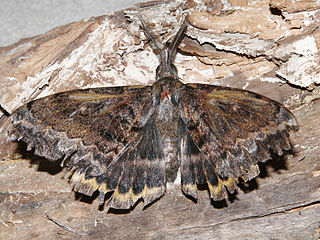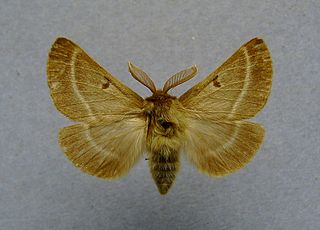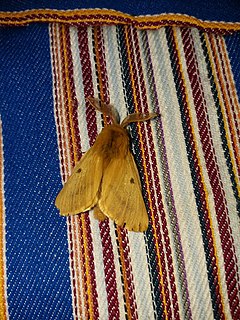
Bombycoidea is a superfamily of moths. It contains the silk moths, emperor moths, sphinx moths, and relatives. The Lasiocampoidea are close relatives and were historically sometimes merged in this group. After many years of debate and shifting taxonomies, the most recent classifications treat the superfamily as containing 10 constituent families. Their larvae often exhibit horns.

Anthelidae is a family of Australian lappet moths in the order Lepidoptera. It had earlier been considered to be part of the Lasiocampoidea superfamily, but a 2008 molecular phylogenetic study, supported by a 2011 study, resulted in reincluding the Anthelidae in the superfamily Bombycoidea.

Brahmaeidae is a family of insects in the order Lepidoptera, commonly known as Brahmin moths. It includes species formerly included in the family Lemoniidae.

The Bombycidae are a family of moths. The best-known species is Bombyx mori (Linnaeus) or silkworm, native to northern China and domesticated for millennia. Another well-known species is Bombyx mandarina, also native to Asia.

Apatelodidae, the American silkworm moths, is a family of insects in the order Lepidoptera. They are a family within the superfamily Bombycoidea.

Lemonia dumi is a species of moth of the family Brahmaeidae. It is found in scattered populations in Central Europe.

Lemonia taraxaci, the autumn silkworm moth, is a species of moth of the family Brahmaeidae. It was first described by Michael Denis and Ignaz Schiffermüller in 1775 and it is found in south-eastern Europe.

Lemonia balcanica is a species of moth of the family Brahmaeidae. It is found in the Balkans.

Lemonia philopalus is a species of moth of the family Brahmaeidae. It is found from Spain up to Egypt and North Africa.

Lemonia vallantini is a species of moth of the family Brahmaeidae. It is found in Morocco, Algeria and Tunisia.

Lemonia is a genus of moths in the family Brahmaeidae (older classifications placed it in the separate family Lemoniidae.
Sabalia is a genus of moths in the family Brahmaeidae.
Lemonia ballioni is a species of moth of the family Brahmaeidae. It was described by Hugo Theodor Christoph in 1888. The range includes Turkey, Ukraine and Russia.
Lemonia beirutica is a species of moth of the family Brahmaeidae. It was described by Franz Daniel in 1965. The range includes Israel and Lebanon.
Lemonia pauli is a species of moth of the family Brahmaeidae. It was described by Otto Staudinger in 1894. Its range includes Israel, Syria, Jordan and Lebanon.

Lemonia peilei is a moth in the family Brahmaeidae. It was described by Walter Rothschild in 1921.
Lemonia pia is a moth in the family Brahmaeidae. It was described by Rudolf Püngeler in 1902.
Lemonia ponticus is a moth in the family Brahmaeidae. It was described by Per Olof Christopher Aurivillius in 1894.
Lemonia sacrosancta is a moth in the family Brahmaeidae. It was described by Rudolf Püngeler in 1902.
Lemonia sardanapalus is a moth in the family Brahmaeidae. It was described by Otto Staudinger in 1887. It is known from Turkmenistan.











